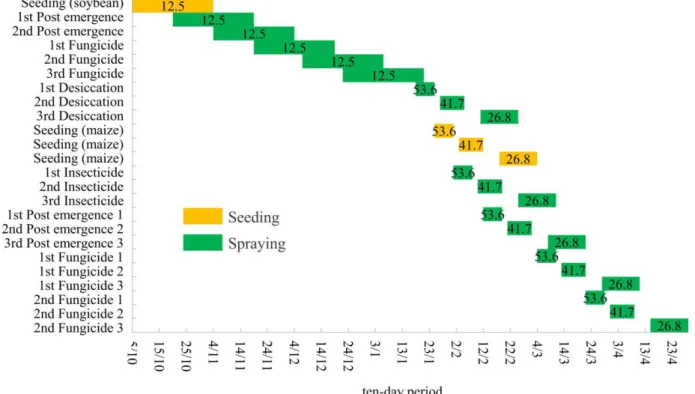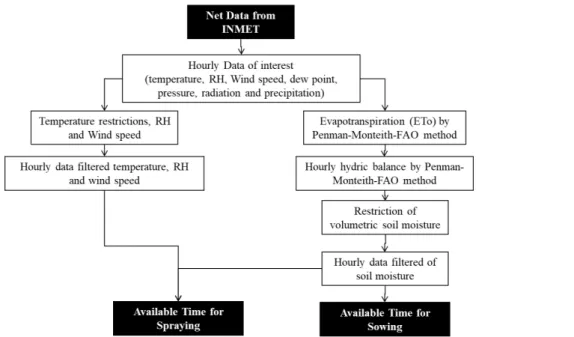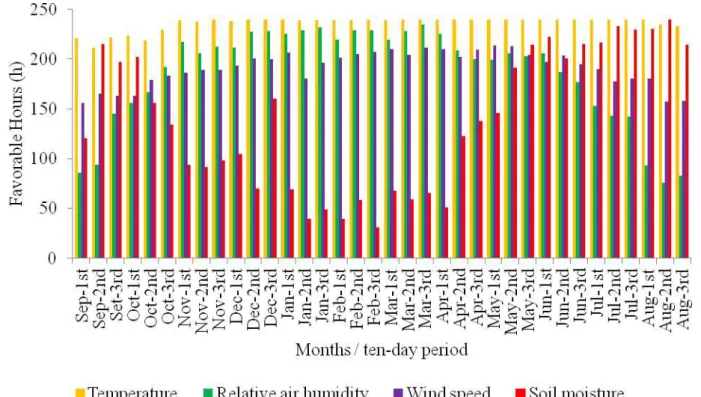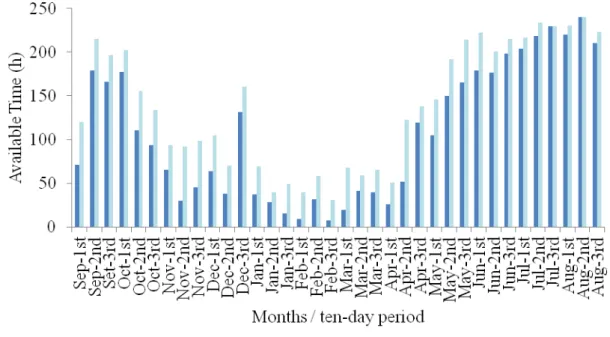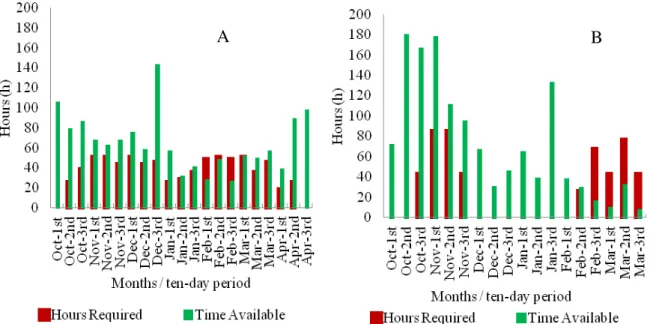ISSN: 1809-4430 (on-line) www.engenhariaagricola.org.br
1 Universidade Federal de Mato Grosso do Sul/ Chapadão do Sul - MS, Brazil. Received in: 8-23-2017
Accepted in: 3-14-2018
Doi: http://dx.doi.org/10.1590/1809-4430-Eng.Agric.v38n3p443-450/2018
ARTIGO TÉCNICO
TIME AVAILABLE FOR SPRAYING AND MECHANIZED SOWING IN THE NORTHEAST
OF THE STATE OF MATO GROSSO DO SUL AND SOUTH OF GOIÁS
Ricardo Gava
1, Igor M. Scarpin
1, Fabio H. R. Baio
2*, Carlos R. Wassolowski
1, Danilo C. Neves
12*Corresponding author. Universidade Federal de Mato Grosso do Sul/ Chapadão do Sul - MS, Brazil. E-mail: fabiobaio@ufms.br
KEYWORDS
Agricultural
machines, selection of
machines, mechanized
systems.
ABSTRACT
The sizing of mechanized agricultural systems depends on the soil and climatic
conditions, the crop and the work regime. The aim of this study was to determine the
probabilities of time available during an agricultural year for mechanized spraying and
sowing in the northeast region of the State of Mato Grosso do Sul and south of Goiás. The
meteorological restrictions imposed as unfavorable hours were: ambient temperature
above 32ºC, relative air humidity below 50%, wind velocity above 15 km h
-1and soil
volumetric moisture above 39% (humidity equivalent to 90% of the available water
capacity for the studied soil). The mathematical models were elaborated for eight years,
based on the historical data of the automatic station of the National Institute of
Meteorology installed in the region. It was possible to determine the time available for
mechanized sowing and agricultural spraying operations. The available times for every
ten days of the agricultural year for mechanized spraying and sowing in the study region
were determined. The hourly water balance is used for the restrictive study of soil
moisture in determining the time available for mechanized operations. A single
self-propelled sprayer (30 m bar) and a single seed drill (48 rows) are not sufficient to meet the
operational rate in an area of 3,000 ha in the northeast of the state of Mato Grosso do Sul
and south of Goiás.
INTRODUCTION
It is essential to select the mechanized systems correctly, so there is no over-dimensioning or idleness of the agricultural machinery (Couto et al., 2012). The adequacy of the mechanized agricultural system that performs the processes of implantation, conduction, and harvest of the commercial crops is a strategic point for the improvement of the profitability since it can represent from 20 to 40% of the costs of production (Milan & Rosa, 2015). However, the mechanized agricultural processes, such as soil tillage, sowing, fertilization, irrigation, spraying, and harvesting, depending on favorable weather conditions and specific soil moisture so that they can be efficiently carried out.
The use of seed drills is dependent on soil conditions, mainly moisture, which in turn is linked to precipitation and evaporation. It is possible to determine the probability of occurrence of precipitation in a given period and, based on this information, calculate the needs
of machines to perform the mechanized practices (Ataíde et al., 2012). Soils with moisture contents close to field capacity (FC) or higher allow the soil particles to aggregate to the implement, besides favoring the compaction, which may cause a reduction in the work rate or machine downtime, reducing operational efficiency (Furlani et al., 2013).
The care to minimize soil compaction is of utmost importance due to the high level of traffic of machines and implements used in modern farming systems. The soil compaction adversely affects root growth and, consequently, decreases the crop productivity (Bastiani et al., 2012). The increase of soil density due to the traffic of the machines causes the loss of the stability of its aggregates and affects the development of the plant root system (Cardoso et al., 2013).
soil consistency indicates the optimal moisture range for mechanical soil mobilization. However, the literature does not show the ideal soil moisture (as a percentage of FC) for the sowing operation, according to its different textures conditions.
The mechanized agricultural spraying may also contribute to soil compaction when used in high moisture conditions, as well as in mechanized sowing. However, spraying under unfavorable conditions in relation to meteorological factors may further compromise the application result. The ideal meteorological conditions for the applications of pesticides are established as the temperature below 30°C, relative humidity above 55% and wind speed between 3 and 12 km h-1 (Cunha et al., 2016).
Therefore, it is possible to account for unfavorable moments for spraying during the day, allowing the exact calculation of the available time (AT) for this operation.
Spraying in poor weather conditions can lead to decreased target control due to drift losses. In agricultural spraying, the drift is defined as the deposition of pesticides outside the application target (Baio & Antuniassi, 2015), a complex phenomenon due to the combination of several factors, mainly the meteorological factors (Al Heidary et al., 2014).
Thus, to meet the restrictive conditions imposed on AT, whether climatic or soil moisture, it is essential for the proper planning of the Operational Rate (OR) of mechanized operations, among which are spraying and sowing. The aim of this study was to determine the probabilities of time available during the agricultural year for mechanized spraying and sowing in the northeast region of the State of Mato Grosso do Sul and south of Goiás.
MATERIAL AND METHODS
In the study, the agricultural operations planning for the Amanbaí farm, located in the municipality of Chapadão do Céu-GO; it was used according to the planned cultivation of soybeans and maize of the second harvest of the agricultural year of 2016/2017, obtained from the technical owner of the property. The geographic
coordinates of the area are 18º48’70”S and 52º36’94”W,
located in the Cerrado biome and regionally known as the region of the chapadões (Chapadão do Sul-MS, Costa
Rica-MS and Chapadão do Céu-GO).
The soil of the area is classified as Dystrophic Red Latosol (EMBRAPA, 2013), with clay texture and average clay content of 440 g kg-1. The average annual rainfall is
2,196 mm, and the average temperature is 22.5°C. The climate of the region is characterized, according to the Köppen classification, as the tropical climate with the dry season in winter (Aw). Its average altitude is 815 m, with predominantly smooth slope relief between 1 and 2%.
The farm has a John Deere seed drill, DB model (Horizontina, Brazil), and a John Deere self-propelled sprayer, 4730 model (Catalão, Brazil). Thus, the simulation calculation scenario was planned according to the availability of these machines and the scheduling of the property operational activities. The decision for this scenario was due to the fact that it is representative of the machine park of the properties in the region, as well as the programming of these activities. The total actual area of 3,000 ha is divided into thirty plots of 100 ha each. The planning of the activities foreseen in the ten days is shown in Figure 1. The working day stipulated for the simulated scenario was of 8 hours per day.
FIGURE 1. Gantt graph and operational rate (ha h-1) of the planned activities for the first harvest (soybean) and the second
The historical data of eight agricultural years (September 1, 2007, to August 31, 2015) were obtained from an automatic meteorological station of the National Institute of Meteorology (INMET), located in the municipality of Chapadão do Sul-MS, which fed mathematical models of hourly water balance by the Penman-Monteith-FAO model (Allen et al., 1998).
These models were programmed using a Visual Basic suitable programming language (VBA) with the help of macros in Excel®. The meteorological restrictions imposed on the favorable hours for the operations were: ambient temperature above 32ºC, relative air humidity below 50%, wind velocity above 15 km h-1 and soil
volumetric moisture above 39% (moisture equivalent to 90% of the available water capacity for the studied soil). For the mechanized sowing, a comparison was made for two conditions of soil volumetric moisture (80 and 90% of the Field Capacity - FC).
For the calculation of the water balance, the Reference Evapotranspiration (ETo) was determined by Penman-Monteith-FAO hourly method (Allen et al., 1998), being considered a no-tillage soil with 2.5 t ha-1 of
wheat straw cover, with coefficient of evaporation (Ke) of 0.6 (Gava et al., 2013) and with a water storage depth of 0.2 m. The sequence of calculations was defined by macros in an electronic spreadsheet (Figure 2).
FIGURE 2. Schematic representation of the calculations sequence for the definition of Available Time of agricultural operations.
The mathematical model of the restrictions was applied to a real agricultural scenario, proposed by the planning of the hours necessary for spraying and sowing, allowing statistical analysis of AT, according to the OR of these mechanized operations.
The operational field capacity (OFC) was calculated from the dimensional data of the machines and the operational efficiency estimates presented by ASAE (2015). The average speed used in the spraying was 22.0 km h-1 (6.1 m s-1), the effective width of 30 m and an
average efficiency of 60%, giving the OFC of 39.6 ha h-1,
as they occur in the field conditions of the farm. The OFC of the seeder was calculated at 12.2 ha h-1, considering the
average speed of 7.5 km h-1 (2.1 m s-2), the effective width
of 21.6 m (48 rows of planting) and average operating efficiency of 75%.
The frequency analysis allowed estimating the probability of occurrence of a given maximum number of hours for each mechanized activity in every ten days, using the Kimball method (Equation 1).
(1) Where,
F - frequency; M - order number, and
N - the number of years of observation.
With the aid of the condition function of Excel®, the AT given by each restriction of agricultural spraying and mechanized sowing was also accounted. Thus, the factor that most affected the AT reduction for agricultural operations was determined. The ATs for agricultural spraying and mechanized sowing were contrasted with ORs proposed by the real scenario.
RESULTS AND DISCUSSION
FIGURE 3. Favorable hours for mechanized agricultural spraying according to the restrictions of air temperature, relative air humidity, wind speed and soil moisture.
The restriction of the relative air humidity variable (RH) by itself only limited the mechanized spray (Figure 3), since the restrictive hours occurred during the months from June to September, a period without cultivation of commercial crops. The minimum value of AT according to this restriction was 75 h, in the second ten days of August. The month of March presented the highest value, in 235 h, and the average AT for spraying was around 185 h for the agricultural year. The RH limit is exceeded during the hottest hours of the day, between 12:00 and 17:00 h. It was observed that at times when the wind speed exceeds the limits, the relative air humidity also surpasses.
The spraying at times where the RH is unfavorable can compromise the deposition of agricultural pesticides on the target. A lower deposition of glyphosate spray at times where the temperature and relative humidity conditions are less favorable to the applications was observed in an experiment using artificial targets in the evaluation (Nascimento et al., 2012). However, increasing the size of the spray droplets can sometimes circumvent this restriction. Thick droplets are less prone to evaporation and wind drift, but they are more likely not to stick to the target and drain into the soil (Czaczyk et al., 2012).
The number of available hours limited by wind speed (Figure 3) was the second most limiting factor to agricultural spraying, characterized by the number of ten days with AT less than 200 h. The average of AT according to this restriction was 156 h. However, the soil moisture suitable for mechanized agricultural spraying, when minimizing compaction, is the most restrictive factor
to the AT among the four factors. The lowest AT was 30 h in the third ten days of February, lower than the OR of the spraying presented by the property scenario during the same period. Thus, there will be excessive compaction of the soil due to the traffic of machines in poor conditions of humidity. The average AT in the period, restricted by soil moisture, was 138 h.
The rainy months are the most limiting, due to the time of evaporation so that the soil reaches the adequate humidity, in order to reduce the problem of its compaction by the route of the sprayer, as Baio et al. (2017) affirm. Although the Latosols present excellent physical properties, their inadequate management, through the revolving and the traffic of agricultural machines of concentrated form, has favored their compaction (Valicheski et al., 2012; Ataíde et al., 2012).
FIGURE 4. Available time for agricultural spraying for the region studied, relating the restrictions of air temperature, relative air humidity, wind speed and soil moisture.
As in spraying, the soil moisture restriction limits AT in several ten days of the agricultural year for mechanized sowing (Figure 5). In the ten days of October, when the sowing of the first harvest is carried out in the region considered, the soil moisture remains favorable for a more extended period. In the ten days period referred to the peak of the sowing operation of the second harvest (January and February), the AT is lower in relation to the other ten days of the year and may not be enough to complete the sowing operation under the appropriate soil moisture conditions, depending on the total OFC installed at the farm.
FIGURE 5. Available time for mechanized sowing, after soil moisture restriction at 80 and 90% of available soil water.
The most deficient hours available for mechanized sowing are concentrated between the months of November and April. For the sowing of the maize crop in the second harvest, the required OR established by the presented scenario was between 26.8 and 53.6 ha h-1 (Figure 1).
However, this OR is not exercised if the need for soil
stops for cleaning the seeder tools. In very humid soils, the seed distribution becomes impaired by the soil adhesion to the implement (Portella et al., 1997). Although the friability point of the soil is close to 90% of the FC, it is desirable, at the sowing, even lower humidity than that related to this point, due to the possibility of occurrence of excessive stops for cleaning the aggregate materials in the seeder furrow systems. When the soil moisture is above the point of friability, the soil particles adhere more easily to the implements grooving elements, causing their malfunction and generating sowing failures.
The hours necessary to meet the OR, according to the OFC simulation for the 3,000 ha, in the February-March ten days exceed the time available for mechanized spraying (Figure 6A). During this period, there is the need for desiccation operations in soybean crop (harvest) and the first applications of the post-emergence herbicide, as well as the application of insecticides for the control of bedbugs in the maize of the second harvest. Therefore, it is understood that the farmer carries out the spraying under conditions of high soil moisture, leading to higher compaction in the path of the sprayer. The increase in soil
density and compaction is mainly related to the traffic of machines (Baio et al., 2017).
The hours available for the sowing of the soybean crop in the harvest period were sufficient in all the ten days, supplying the need given by the OR (Figure 6B). The execution of the sowing of the simulated scenario occurs according to the planning, most probably, due to the rains still being irregular in this period where the soil moisture elevation occurs. However, the time available for the sowing of the maize crop in the second harvest does not occur in sufficient quantity to complete the sowing according to the planning. With the exception of the first ten days during the sowing of the second harvest, in all other ten days, there is a negative balance in the time available, resulting in a higher quantity of mechanized systems required to perform this task in the planned period, or sowing with the soil in condition of moisture near or superior to the FC, condition where the soil is more vulnerable to the compaction process, besides reducing the operational efficiency of the sowing due to the soil particles adhering in excess to the implement.
FIGURE 6. Time Available to agricultural spraying (A) and mechanized sowing (B) in relation to the hours required to meet the simulation of the Operational Rate in the ten days of the agricultural year.
There is a need for two self-propelled sprayers (total OFC of 79.2 ha h-1) to meet the OR in the most
restrictive ten days (third of February) in this working region, according to the presented scenario. At sowing, there is a need for three mechanized systems (total OFC of 36.6 ha h-1) to meet the OR of this operation in the most
restrictive decennial (third of January).
Table 1 presents the probabilities of overcoming, of occurring a maximum number of hours of each activity, calculated based on the climatic history of eight harvests. Observing the second ten days of September with 31 h favorable for spraying, the probability of occurring this maximum number of hours is 80%. Every ten harvests, two of them can present even fewer hours. Many
occurrences have the number of hours equal to zero, meaning that for that specific level (probability of overcoming), there is no available time. Thus, it is not possible to perform the planned spraying in the second and third ten days of January and the second ten days of March for the presented scenario, even at a 50% probability of overrun. It is only possible to comply with OR for this operation if the probability of overcoming is reduced to 30%, the probability of the number of hours occurring with sufficient time for spraying is only in three years from ten. In this case, the aerial application can be an alternative to reach OR, avoiding the excessive traffic of machines in the areas with the soil moisture under risk of compaction.
TABLE 1. Available Time (h) for the mechanized spraying and sowing operations, according to the probability of overcoming to be equalized, in every ten days of the agricultural year and according to a historical series of eight years.
Total Available Time per Ten Days (h)
Spraying (probability of overcoming) Sowing (probability outgrowth)
10 days 50% 60% 70% 80% 90% 50% 60% 70% 80% 90%
Sep-1st 15 3 0 0 0 107 56 0 0 0
Sep-2nd 63 42 41 31 1 224 178 167 84 0
Sep-3rd 79 79 74 65 28 240 225 66 0 0
Oct-1st 115 94 50 9 6 210 206 141 84 13
Oct-2nd 47 46 40 36 27 86 71 38 15 0
Oct-3rd 78 68 50 34 33 98 79 71 55 44
Nov-1st 68 23 9 7 0 19 17 6 0 0
Nov-2nd 46 45 38 7 5 5 2 0 0 0
Nov-3rd 52 31 16 14 0 28 14 0 0 0
Dec-1st 62 36 5 0 0 51 34 0 0 0
Dec-2nd 47 35 26 13 12 12 7 7 0 0
Dec-3rd 131 114 76 76 70 93 71 70 57 52
Jan-1st 38 30 7 0 0 0 0 0 0 0
Jan-2nd 0 0 0 0 0 0 0 0 0 0
Jan-3rd 0 0 0 0 0 0 0 0 0 0
Feb-1st 6 5 0 0 0 0 0 0 0 0
Feb-2nd 20 0 0 0 0 0 0 0 0 0
Feb-3rd 16 0 0 0 0 0 0 0 0 0
Mar-1st 48 24 0 0 0 0 0 0 0 0
Mar-2nd 0 0 0 0 0 0 0 0 0 0
Mar-3rd 17 2 0 0 0 0 0 0 0 0
Abr-1st 11 9 7 5 1 0 0 0 0 0
Apr-2nd 102 50 35 21 7 14 0 0 0 0
Apr-3rd 114 28 26 18 0 180 0 0 0 0
May-1st 88 73 51 40 36 81 54 0 0 0
May-2nd 164 159 72 71 68 177 109 96 25 0
May-3rd 172 161 140 116 76 176 158 106 86 0
Jun-1st 152 149 148 139 87 240 224 123 64 0
Jun-2nd 156 115 110 58 50 240 234 93 63 0
Jun-3rd 142 127 104 81 66 240 240 240 78 26
Jul-1st 130 110 78 50 20 240 240 240 153 0
Jul-2nd 114 104 86 61 41 240 240 240 203 84
Jul-3rd 95 93 78 58 40 240 240 240 240 149
Aug-1st 53 51 42 27 18 240 240 240 240 61
Aug-2nd 54 52 47 37 26 240 240 240 240 239
Aug-3rd 49 35 25 4 0 240 240 240 122 90
It is possible to carry out the sowing operation in the harvest (October) with a probability of 80% occurrence of favorable hours in the period. On the other hand, the probability of overrunning for the sowing under adequate soil moisture conditions is 30% for the second harvest (first and second ten days of February and first of March). Thus, to meet the OR requirements of the sowing according to the presented scenario, the agricultures probably increase the speed of the mechanized system, compromising the seed quality. The ideal sowing speed should correspond to the opening and closing of the groove without excessive soil rotation, allowing a greater uniformity between the seeds (Souza Júnior & Cunha, 2012).
CONCLUSIONS
The available times for every ten days of the agricultural year for mechanized spraying and sowing in the study region were determined.
The hourly water balance is useful for the restrictive study of soil moisture in determining the time available for mechanized operations.
A single self-propelled sprayer (30 m bar) and a single seed drill (48 rows) are not sufficient to meet the operational rate in an area of 3,000 ha in the northeast of the state of Mato Grosso do Sul and south of Goiás.
REFERENCES
Al Heidary M, Douzals JP, Sinfort C, Vallet A (2014) Influence of spray characteristics on potential spray drift of field crop sprayers: A literature review. Crop Protection 63(1):120-130. DOI:
Allen RG, Pereira LS, Smith M, Raes D, Wrigth JL (2005) FAO-56 dual crop coefficient procedure for predicting evaporation from soil and application extensions. Journal of Irrigation and Drainage Engineering 131(1):1-12. ASAE D497.7 (2015) Agricultural machinery management data. St. Joseph, ASAE Standards. 9p. Ataíde LT, Caramori PH, Ricce WS, Silva DAB, Souza JRP (2012) The probability of potentially useful work days during the year in Londrina. Semina 33(6):2215-2226. Baio FHR, Antuniassi UR (2015) Pulverização automática. Cultivar Máquinas 8(158):16-18.
Baio FHR, Scarpin IM, Roque CG, Neves DC (2017) Soil resistance to penetration in cotton rows and interrows. Revista Brasileira de Engenharia Agrícola e Ambiental 21(6):433-439. DOI: http://dx.doi.org/10.1590/1807-1929/agriambi.v21n6p433-439.
Bastiani F, Uribe-Opazo MA, Dalposso GH (2012) Comparison of maps of spatial variability of soil resistance to penetration constructed with and without covariables using a spatial linear model. Engenharia agrícola 32(2):393-404.
Cardoso EJBN, Vasconcellos RLF, Bini D, Miyauchi MYH, Santos CA, Alves PRL, Paula AM, Nakatani AS, Pereira JM, Nogueira MA (2013) Soil health: looking for suitable indicators. What should be considered to assess the effects of use and management on soil health? Scientia Agricola, 70(4):274-289.
Couto RF, Cunha JPB, Reis EF (2012) Modelo de programação linear para seleção de diferentes formas de pulverização agrícola para cana-de-açúcar. Revista Engenharia na Agricultura 20(6):529-536.
Cunha JPAR, Pereira JNP, Barbosa LA, Silva CR (2016) Pesticide application windows in the region of Uberlândia-MG. Bioscience Journal 32(2):403-411.
Czaczyk Z, Kruger G, Hewitt A (2012) Droplet size classification of air induction flat fan nozzles. Journal of Plant Protection Research 52(4):415-420.
EMBRAPA (2013) Sistema brasileiro de classificação de solos. 3.ed. Brasília, 353p.
Furlani CEA, Canova R, Cavichioli FA, Bertonha, RS, Silva RP (2013) Demanda energética por semeadora-adubadora em função da haste sulcadora na semeadura do milho. Ceres 60(6):885-889.
Gava R, Freitas PSL, Faria RT, Rezende R, Frizzone JA (2013) Soil water evaporation under densities of coverage with vegetable residue. Engenharia Agrícola 33(1):89-98. Milan M, Rosa JHM (2015) Corte, transbordo e transporte (CTT): aspectos relevantes e uso da modelagem para o CTT. In: Belardo GC. Processos agrícolas e mecanização da cana de açúcar. Jaboticabal, SBEA, p 415-428. Nascimento AB, Oliveira GM, Balan MG, Higashibara LR, Abi Saab OJG (2012) Deposição de glifosato e utilização de adjuvante para diferentes pontas de
pulverização e horário de aplicação. Revista Brasileira de Tecnologia Aplicada nas Ciências Agrárias 5(2):105-116. Nicolai M, Christoffoleti PJ (2014) Tecnologia de aplicação de herbicidas. In: Monquero PA. Aspectos da biologia e manejo das plantas daninhas. São Carlos, RiMa, p 307-350.
Portella JA, Satler A, Faganello A (1997) Índice de emergência de plântulas de soja e milho em semeadura direta no Sul do Brasil. Engenharia Agrícola 17(2):71-78. Souza Júnior RL, Cunha JPAR (2012) Desempenho de uma semeadora de plantio direto na cultura do
milho. Revista Agrotecnologia 3(1):81-90.
